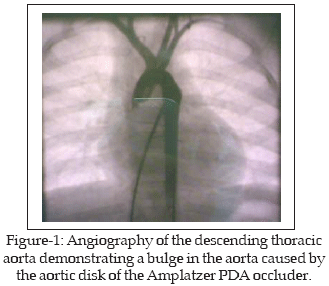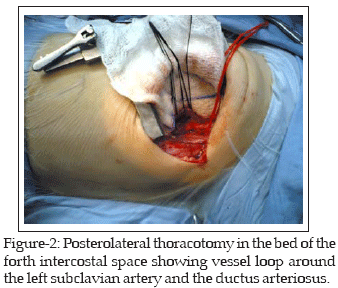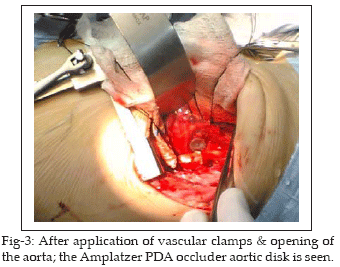|
|
||||
|
Published by : PROFESSIONAL MEDICAL PUBLICATIONS |
||||
|
ISSN 1681-715X |
||||
|
||||
|
- |
||||
|
CASE REPORT |
||||
|
- |
||||
|
Volume 23 |
January - March 2007 |
Number 1 |
||
|
|
||||
|
|
||||
|
|
||||
|
Published by : PROFESSIONAL MEDICAL PUBLICATIONS |
||||
|
ISSN 1681-715X |
||||
|
||||
|
- |
||||
|
CASE REPORT |
||||
|
- |
||||
|
Volume 23 |
January - March 2007 |
Number 1 |
||
|
|
||||
|
|
||||
A complication of the Amplatzer PDA
occluder requiring Surgical Correction
Basel Harahsheh1
ABSTRACT
Trans-catheter occlusion of patent ductus arteriosus is the standard of care. We present a case of aortic coarctation secondary to Amplatzer PDA occluder (PDO) deployment treated surgically by device explantation.An eighteen month old boy had an Amplatzer PDA occluder implanted at the age of one year; presented with aortic coarctation; where the aortic disc of the PDA occluder was protruding into the aorta.He then underwent successful surgical retrieval of the PDA occluder and correction of aortic coarctation with ligation of patent ductus arteriosus.
Key Words: Amplatzer device, Patent Ductus Arteriosus Complications, Surgical correction, PDA occluder.
Pak J Med Sci January - March 2007 Vol. 23 No.1 130-131
1. Dr.Basel Harahsheh
Department of Cardiac Surgery,
Queen Alia Heart Institute,
Prince Hamzeh Suburb,
P.O. Box: 134, Amman-11733,
Jordan.
Correspondence
Dr. Basel Harahsheh
E-mail: basel_md@hotmail.com
* Received for Publication: July 24, 2006
* Accepted: September 14, 2006
INTRODUCTION
Transcatheter occlusion of patent ductus arteriosus is currently the standard of care in many centers throughout the world.
1 The Amplatzer PDA occluder is one of the most popular devices available. The Amplatzer PDA occluder is a self-expanding nitinol double-disk device. It consists of two disks of varying sizes with the larger disk positioned at the aortic end.2CASE REPORT: A one year old boy had an Amplatzer PDA occluder implanted for a hemodynamically significant patent ductus arteriosus.Several months later he presented with poor feeding and irritability. Full diagnostic work up revealed a hemodynamically significant aortic coarctation with peak gradient of 70 mmHg. Aortic angiography demonstrated a shelf caused by the protrusion of the aortic disk into the aorta and on pull back a gradient of 70 mmHg was recorded (Figure-1)

He was then taken to the operating room where a posterolateral thoracotomy was performed in the bed of the forth intercoastal space and dissection to isolate the ductus, the descending thoracic aorta, the left subclavian artery and the aortic arch was performed (Figure-2).

After administering 1mg/kg Heparin vascular clamps were applied. The aorta was opened and the protruding aortic disk could easily be seen in the lumen of the descending thoracic aorta (Figure-3). The device was removed, the ductus ligated and the aortic coarctation repaired. It was possible to repair the aortic coarctation primarily just by excising the Amplatzer device and no gradient was recorded after primarily closing the aorta.

DISCUSSION
Tran catheter occlusion of patent ductus arteriosus is currently the standard of care in many centers throughout the world.
1 The Amplatzer PDA occluder is one of the most popular devices available. In a large series Hijazi concluded that complications after the PDA Duct Occluder (PDO) were rare; the only complications were two cases of partial left pulmonary artery occlusion and no cases of significant aortic obstruction.1 The Amplatzer PDA occluder is a self-expanding nitinol double-disk device. It consists of two disks of varying sizes with the larger disk positioned at the aortic end.2 In a review article Hijazi and colleagues report a second series with the PDA duct occluder (PDO) without any major compliocation.3In a multicenter study published by Hijazi involving 316 patients there was one fatality and 6 moderate and 8 minor complications. The series did not have any complication with aortic coarctation.
4 Complications regarding the descending thoracic aorta are few and did not include aortic coarctation. A report from New Zeeland reported sub clinical aortic perforation after the PDA duct occluder (PDO) was deployed.5Some investigators have addressed the question of potential creation of aortic coarctation after deployment of Amplatzer PDA duct occluder and found that using a new angled device could reduce that risk. The aortic disk of the angled ADO is angled at 32 degrees to the body of the device and concave toward the aorta to prevent protrusion of the disk into the aorta.
6REFERENCES
1. Pass RH, Hijazi Z, Hsu DT. Multicenter USA Amplatzer patent ductus arteriosus occlusion device trial: initial and one-year results. J Am Coll Cardiol 2004;44(3):513-9.
2. Mashman WE, King SB, Jacobs WC. Two cases of late embolization of Amplatzer septal occluder devices to the pulmonary artery following closure of secundum atrial septal defects. Catheter Cardiovasc Interv 2005;65(4):588-92.
3. Thanopoulos BD, Hakim FA, Hiari A, Hijazi ZM. Patent ductus arteriosus equipment and technique. Amplatzer duct occluder: intermediate-term follow-up and technical considerations. J Interv Cardiol 2001;14(2):247-54.
4. Faella HJ, Hijazi ZM. Closure of the patent ductus arteriosus with the Amplatzer PDA device: immediate results of the international clinical trial. Catheter cardiovasc Interv 2000;51(1):50-4.
5. Wilson NJ, Occleshaw CJ, O’Donnell CP. Subclinical aortic perforation with the infant double-button patent ductus arteriosus occluder. Catheter Cardiovasc Interv 1999;48(3):296-8.
6. Masura J, Gavora P, Podnar T. Transcatheter occlusion of patent ductus arteriosus using a new angled Amplatzer duct occluder: Initial clinical experience. Catheter Cardio Vasc Interv 2003;58:(2):261-7.
HOME | SEARCH | CURRENT ISSUE | PAST ISSUES
Professional
Medical Publications
Room No. 522, 5th Floor, Panorama Centre
Building No. 2, P.O. Box 8766, Saddar, Karachi - Pakistan.
Phones : 5688791, 5689285 Fax : 5689860
pjms@pjms.com.pk